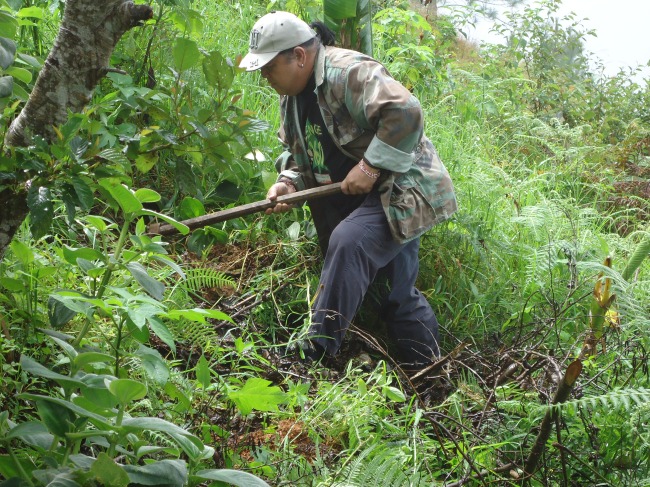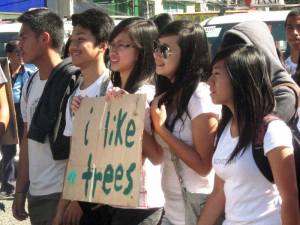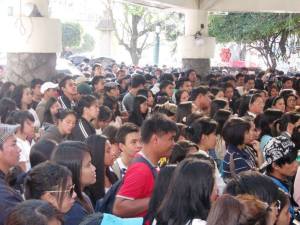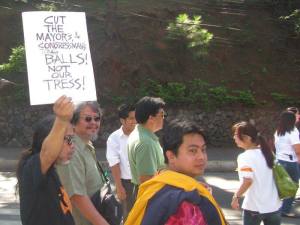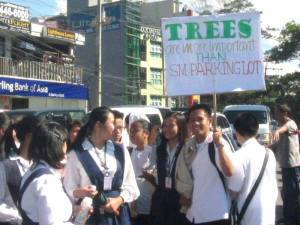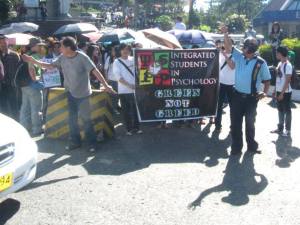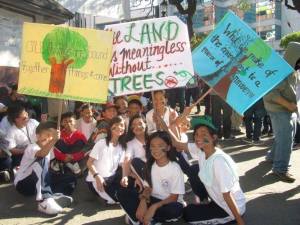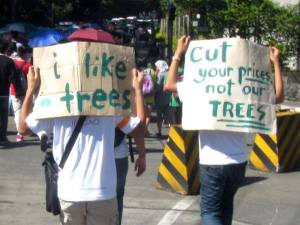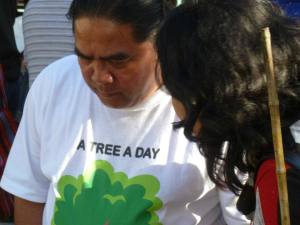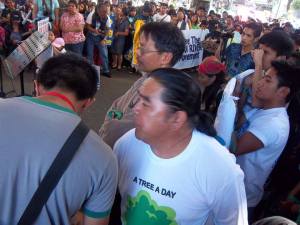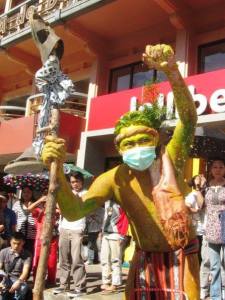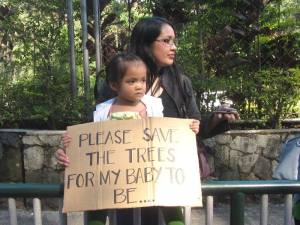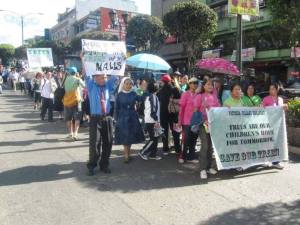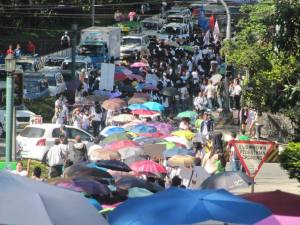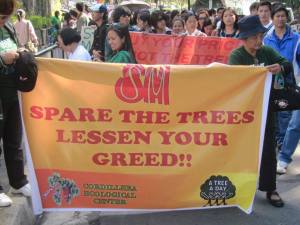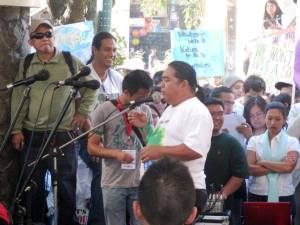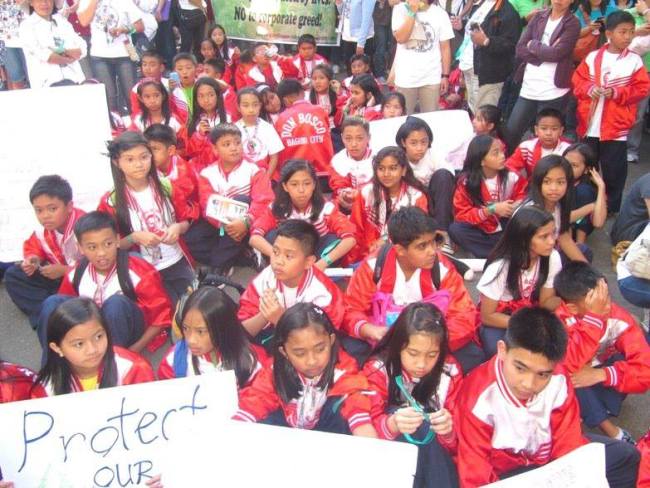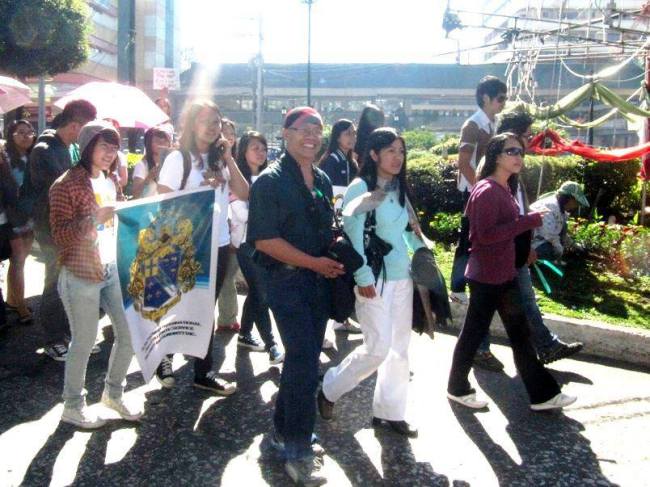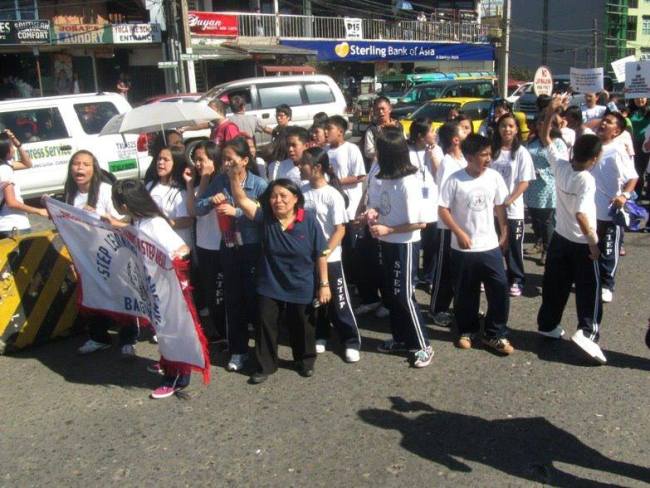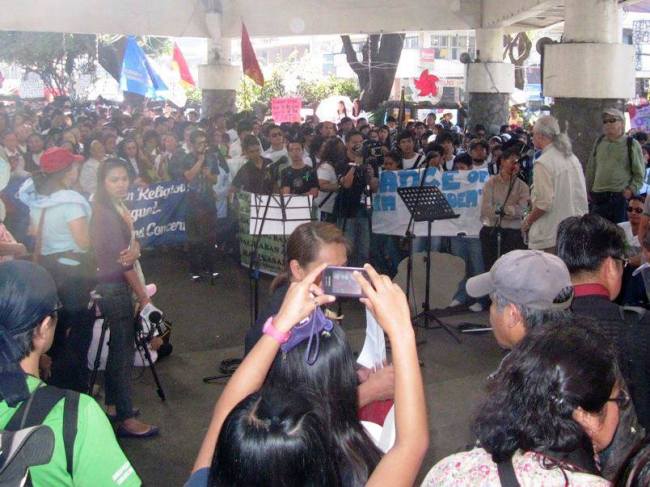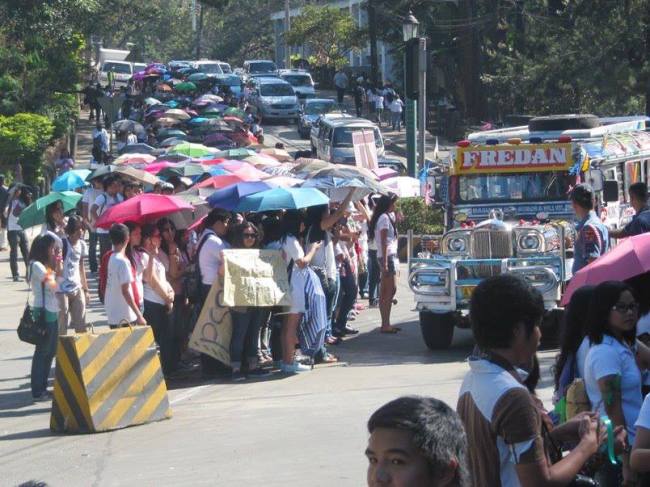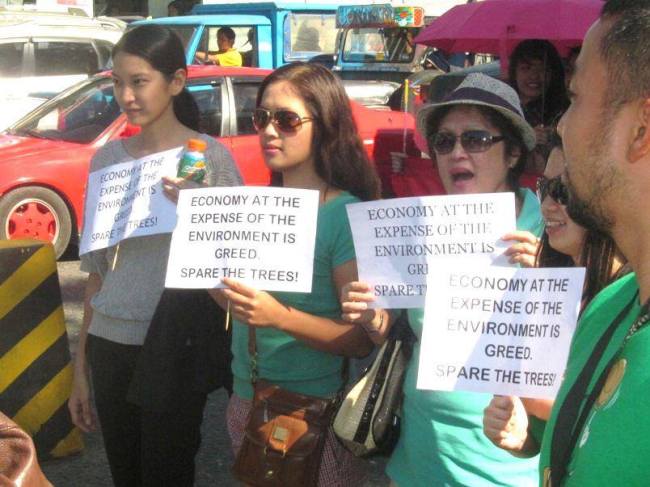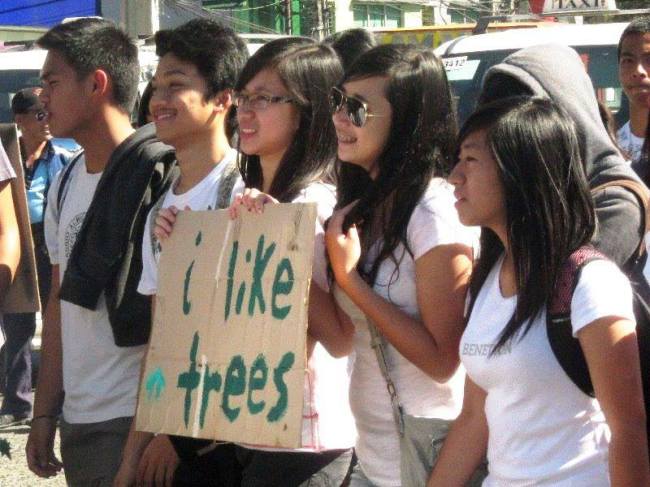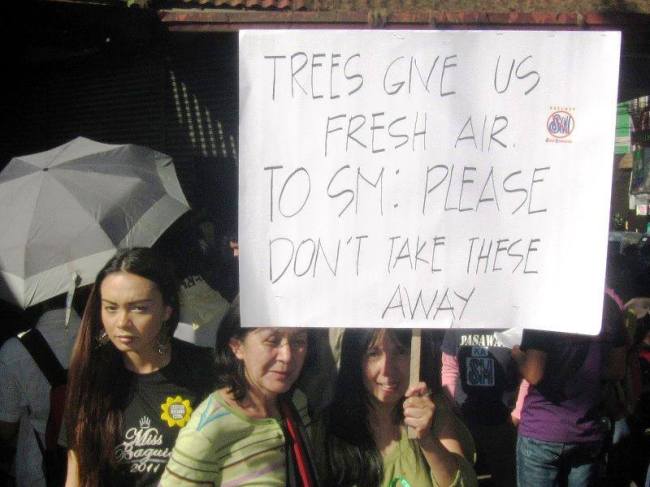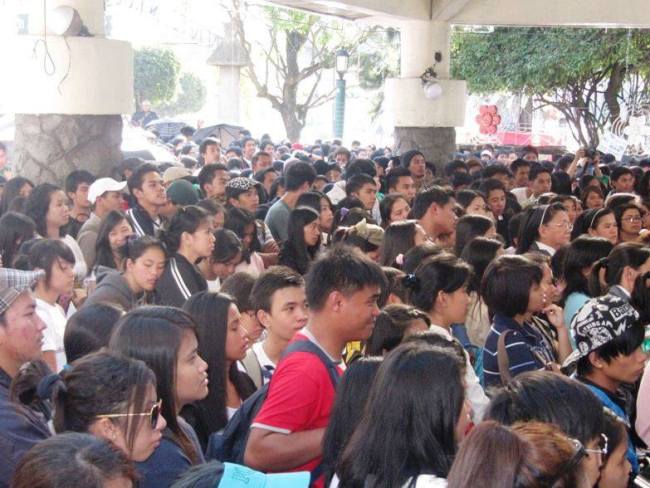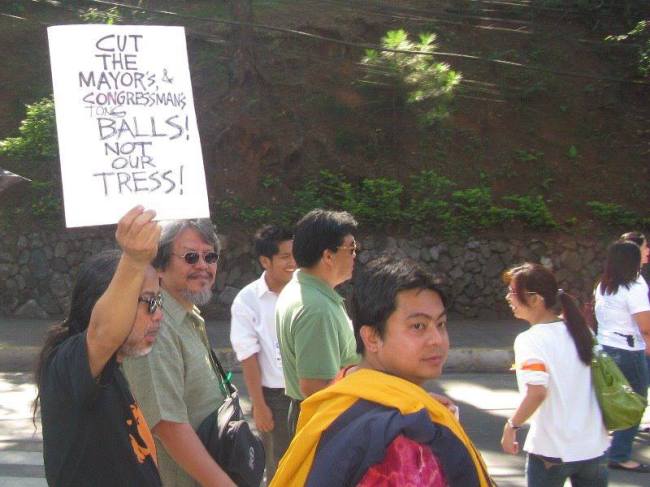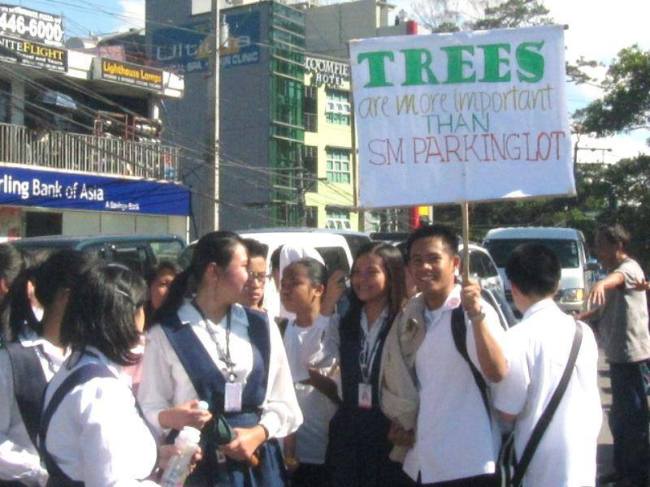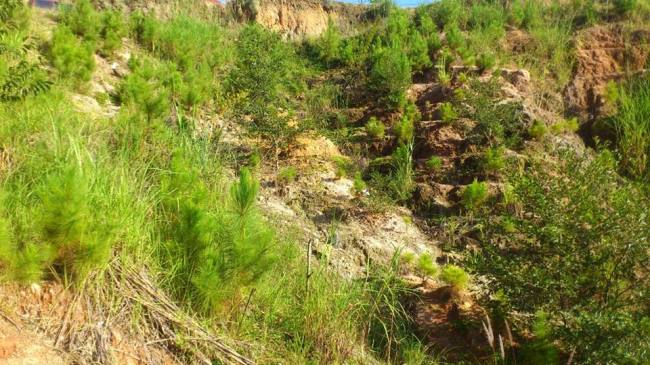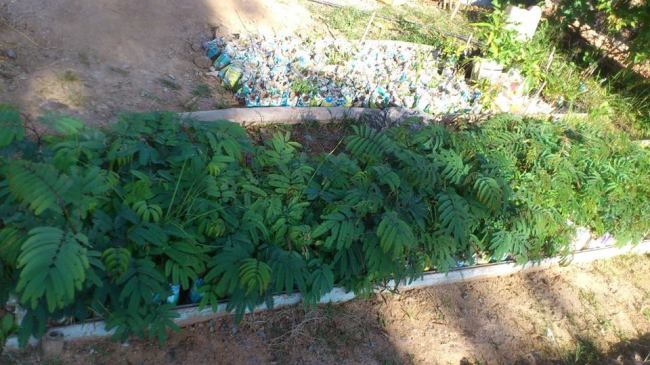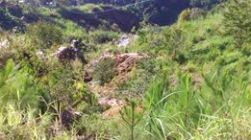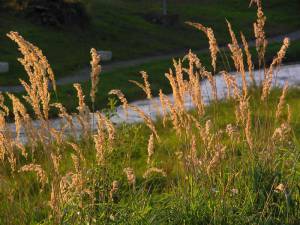Nowhere to Run, Nowhere To Hide:
The Agtas, peace-loving dwellers and guardians of Sierra Madre’s forests,
are slowly and painfully being erased from the Philippine anthropological picture,
by oppression, exploitation and modernization
By MICHAEL A. BENGWAYAN, Fellow of the New York-based Echoing Green Foundation
Palanan, Isabela, Philippines (January 8, 2002) — Salak Dima personifies
what wordsmiths call a “child of the forest”. Since boyhood, he has
hunted, fished, gathered wild food crops, and even farmed. He lived in
the most remote tropical jungles of the Sierra Madre in peace with
nature’s bounty.
That was decades ago. Today, he and his small band of 23 Agta tribespeople
are on the run. Deeper into the forest which may not be around too long.
Soon, they’ll have no place to run. And no place to hide.
Deprived, oppressed, underserved and exploited, they went back to the
forests fearful that if they don’t, their children may undergo their sad
and humiliating experiences. They are seeking refuge to where they have
always known freedom-into the forests. They are running away from the
powerful invading mainstream population who scorn them. From the
military and police authorities who provide them no justice and protection.
And sometimes, from communist rebels, although when caught, they are
treated with respect and courtesy by the insurgents.
With creased wrinkles marking unknown years, Salak recounted through Milo,
my interpreter “Fifty summers ago, we were a proud race of people. Then the
Ilokanos came, Ifugaos, Itnegs bringing along logging and mining. Our lives
were never the same again.”
Salak Dima
No one can recall the trials and betrayals of the Agtas better than Salak
Dima. A man of few but meaningful words. Chosen leader by his elders
(pisen), son of Puptuk, he is the proud grandson of Dakmis, the “centipede
gatherer”. He talked only when spoken to. He looked through you with
shielded-ebony eyes that betrayed any expression.
In my continuing effort to document indigenous knowledge, skills and
practices (IKSP) of indigenous peoples, I trudged into the warm
rain-drenched forest of the Palanan Wilderness Area (PWA), thankful to
serendipity. Right into the midst of Salak’s band who, for the better, are
living the way their ancestors did hundreds of years ago.
Salak brought his people back to the forests. From what we call
“civilization”, where greed, anger and cash mentality prevail. Where human
beings live in a dog-eat-dog world. Where men speak with forked tongue
and will stab you at the back. Where being black, short and
fickle-looking calls for dog-like treatment.
I met Salak one cold damp morning, on the third day of my hike at the foot
of Mount Palanan (1,212 meters). He was squatted with two of his men on a
fire lit by Milo when I crawled out of my water-soaked bag and tent.
Outwardly, he looked menacing with his “kulibew” and “pana” slung over his
shoulders. His half-closed shirt bared scarified breast, intentional
disfigurement made by knife cuts which I never understood why, other than
it was a test for young men’s bravery. Standing just over four feet, he
weighed perhaps no more than a hundred pounds dripping wet from the night’s
rain. I soon found out, he seldom smiled.
Ermelo Arnazar, my contact in Ilagan and Milo provided me little from
whence I can imagine how Salak looked like. “A wise old man made tough
by seeing his people die”, Ermelo said as we parted in Ilagan. “You can’t
find him, He will find you once you and Milo get to the fork of Palanan
river. I sent word you are coming, he knows,” Ermelo shouted as we boarded
the jeep in Ilagan down towards Ilagan river.
What he lacked in size, he makes up with unnerving toughness. A muscle of
vast endurance, he can exist on anything or nothing. As a leader, he is
shrewdly effective in a survival which calls for no rules. I would soon
find out that beneath the stonelike attitude, he had a soft spot –
recollection of grief.
With trousers and worn-out jacket covered with red earth and soot (to
prevent wild animals from smelling him), I placed him to be within fifties,
with a goatee so stiff it can hurt a fly. But looks can be deceiving.
Small callused hands, adept in hunting, proved endless work, some of which
was done slaving in a logging camp.
Milo introduced me to Salak then Kopas and Natuk, distant relatives who by
their looks were in their early 20s. Unlike Salak, both hankered for talk,
as I was, but it was not that easy. Yuggad was the language of the day
and the days that came so I was entirely dumb. I relied much on Milo to
tell me everything, if everything he did tell.
Salak’s questions were few, limited to who I was, why and another why to
Milo’s answers, and two or three more whys. He measured me from head to
toe, half squinting , wondering what the “bulul” (Igorot spirit guard)
was that hung on my neck.
Other than that, I got empty looks even as I continued grinning like a fool
to make him friendly.
People of Lesser God
The Agtas, subtribe of the Negritos or Aetas, are one of the few remaining
indigenous peoples to originally inhabit Luzon. They are now being
threatened to extinction. Scattered sparsely in the Sierra Madre, they can
be found in Cagayan, Isabela, Aurora, Quezon, Qurino, and Apayao. But
their homes in these provinces are now in the hands of lowlanders. They
have been virtually stripped of their land, resource and life base.
Philippine historians are confounded when it comes to the Agta’s history.
One theory says they came to the Philippine shores 30,000 years ago from
Sumatra and Sunda islands. But Noval, Morales, an anthropologist says they
may have come from the Malay Peninsula.
Many scholars of artifacts say they once lived in the lowlands only to be
pushed up to the mountains by incoming Malays and the Spaniards. Whatever
the truth is, Salak told me they once roamed as far as Gabaldon, and
Pantabangan, Nueva Ecija to San Rafael in Bulacan. “We roamed our lands, we
are not nomads, rather, we take time to visit old hunting grounds and
food-gathering areas”, he claimed, disputing common beliefs that they are
always on the move because they own nothing.
“We leave our old homes for the plants to grow once more, for the deer to
give birth and for the “baboy”, (pig), bisukut (lizard) and “bebiyak”
(python) to grow stout. When they do, we go back for them. We are not
wanderers,” he stressed.
“But food is becoming scarce in the forests. “Boday” (traps) are sometimes
empty, “dita” (poison) is often wasted and “bangkolans” (pit-traps)
rarely catch fat pigs,” Salak said with no emotions.
The Agtas as well are diminishing. According to the National Cultural
Communities of the Philippines (NCCP) their number has been declining
rapidly. Their existence is threatened by problems brought by other people.
Poverty-stricken lowlanders have encroached on forests displacing the Agta.
Government negligence and public apathy are marginalizing them, bringing
them to the very edge of extinction.
Salak’s band is representative to such kind of phenomenon, Milo told me. I
was the second outsider guided by Milo to Salak after a missionary in 1998.
That year, Salak had 27 in his band. Salak’s people now desperately live
in “regions of refuge”, the limited areas that are rugged, desolate and
remote which although provide scarce food, offers haven and security in the
Sierra Madre belt.
Although poor by “modern” man’s standards, Salak’s group, I was to
discover, are open handed. Food earned or gathered in a day is shared
without grudge. Distributed in portions called “bunto”, food is shared to
everybody, even to those who are absent at the settlement.
The Long Road To Nowhere
Reaching Salak’s home was no picnic. One has to have legs with sinewy
muscle, a strong back, broad shoulders and lots luck. If not, a litany of
prayers is all one can resort to. The days of hiking seemed longer each day
and the bones, near to breaking, complained. The punishing 21-hour trip from
Baguio to Bontoc to Banaue to Ilagan on a rented old Ford Fiera which
careened to steeply on curves with doubtful brakes on bumpy pot-holed road,
was a comfort compared to the dreary hike.
Milo, much younger than I, is a member and pathfinder of the Sierra Madre
Mountaineering Society. He had been in the trails below Mount Palanan
several times. Familiar with the isolated settlements we passed, I soon
found out on the first day of walk not to keep pace with him. Doing so
all the more made him walk faster. But I did keep my part of the bargain,
never complaining nor stalling our agreed timetable.
Taking a ride from Ilagan to Palanan municipality would take longer, he
said. So we took the hunter’s trail after alighting from the jeepney in
Sitio Waclis, following Palanan river. To somewhere I know not.
What made the travel more difficult was that it was five years ago since I
went for a long hike. That was in Pulag, the country’s second highest
peak. In a span of seven months, I had six 8-hour hikes from Ambangeg to
Pulag, down to Lusod near Ifugao, then up to Pulag once more and then
down to Ambangeg while doing a study for UNDP’s Global Environmental
Facility (GEF) Project. It was followed by two months of eco-profiling
Mt. Chumanchilchil and Buasao Watershed between Abra and Mountain Province
for the World Wildlife Fund (WWF). The place was home, headquarters and
training ground of the New Peoples Army (NPA) and the Cordillera Peoples
Democratic Front (CPDF) for 10 years. The military has since been bombed
the camp to smithereens using Sikorsky gunships and Huey “flying coffins”.
The last time I went into a rainforest was in ’96 in Kalimantan,
Indonesia, with Anhar Kramadisastra, a classmate in Ireland. In the
Philipines, it was in Marag Valley, Luna, Apayao in 1991. Only the
circumstances were different. There, the “thunk” of Army mortars hitting
unseen enemies were audible. Faint “thack-thack-thack” of Kalashnikov
answered distinguishable M-16s, the gun that helped US lose the Vietnam war.
At Palanan, the chirps from Jiminy crickets, nature’s troubadours, were
both noise and music. Birds chirped and monkeys crazily howled atop
unseen treetops. Under the forest floor, slivers of sunray barely reach you
as water and green leeches drip and fall. You walk where there are no
trails, crawl when its too slippery to walk and curse the gods when you
find no way at all. I was a fool not to review my trailblazing handbook.
You have to smoke, even if you don’t, to keep away the mosquitos and insects
and stab on leeches that lovingly cling to your neck, face, and toes. How
leeches get inside hiking shoes is something I want to know.
In Marag, you have to be careful, for bullets evaded no one. Not even
journalists. The fear is more of being caught mistakenly in a crossfire. In
Palanan, you dread the poisonous centipedes, the earwigs, leeches and
skinworms that find their way through your skin if not to any hole in your
body, You sleep body and brain-dead , but mentally awake sensing for
anything that crawls on your skin.
Salak’s camp is somewhere within the 200,000 hectare sprawling Palanan
Wilderness Area (PWA). The PWA, Milo my British-trained guide says, is
the largest protected (if protected at all) rainforest area and the most
important tract of tropical rainforest remaining in the Philippines. It
represents 10 per cent of the nation’s remaining primary forests and home to
the Agtas for 2,500 years.
It will be home if it will be around for another century. Creeping human
invasion to the Palanan wilderness was very evident during the four hour
jeepney trip from Ilagan, six hour hike along Palanan river, and six hour
climb towards Mt. Palanan.
The Agtas need more than wishful thinking to be able to remain on what
will be left of PWA. Illegal logging by small-scale speculators, rattan
harvesting and swidden farming are widespread all the way toward Mt.
Palanan. Biodiversity is endangered as well as the Agta’s intellectual
property and rights.
I went to Palanan to document IKSP particularly on biodiversity before
biopirates grab indigenous peoples’ wealth and knowledge. Through a grant
from the Toyota Foundation, a colleague and I are seeking ways to assist
indigenous peoples document their IKSP as proof and evidence to their
ownership of indigenous knowhow they have nurtured for hundreds of years,
along with the plants they have protected and conserved.
But I had another reason for going to Palanan. My own blood runs deep
Igorot red from ancient headhunting warriors who bragged of the heads they
rolled only to have their heads rolled too by bolder braves. I felt
soul-binding with the Agtas was important for my identity
Inhuman Oppression
>From Mt. Palanan, we took off for the 1,300 meter Mt. Moises, northeast
of Isabela, pushing deep into the Sierra Madre Natural Park, Milo oriented
me as he consulted his GPS. There was little talk, especially so when
Salak mumbled the hike would last with the end of the day. Bah! I recalled
thinking. For him perhaps. Me?
The short breakfast of half- ripe “kamatis” and tuyo passed through the fire
worked no wonders on Salak. His face bore no life, stoic like a western
gunfighter on showdown under a high noon.
But a gift of two Marlboro packs, five boxes of “strike anywhere” matches
and a Swiss knife I hurriedly grabbed at a Copenhagen airport duty free
shop on my way from Sweden to Denmark, changed all that.
Throughout the seven-hour hike, Salak and his two men then showed concern
when we lagged behind, picked edible leaves, berries and shared now and
then, including white worms or grubs, which I courteously declined, under
their mocking eyes. They did talk, in broken Tagalog and Yuggad. But
everything else sounded pidgin to me.
At exactly eight at night, the fourth day, we struck Salak’s camp. It was
made-up of 8 lean-tos, collapsible, movable and easy to transport. Dogs
howled, children came running and voices filled the air. “The stranger is
here” the talk went on, as Milo later told me.
I was too tired to eat or talk, but to refuse food would be an insult. To
my surprise, the food carefully prepared on the ground made me forget I
had aching bones and hurting feet. Salted pig meat boiled with “aduas”
leaves and “litilit” vine (often used as tea to ease muscle pains
effectively).. Boiled and dried crisp “udang” (crayfish) bigger than my
thumbs and pound cassava. At the end of the meal, I was licking my
fingers.
The following day, the tribesmen talked, sometimes all together at a time.
The women whispered among themselves. Only Salak’s hand would interrupt
them. I brought some tobacco, matches, dried fish (only to find out
there is a bounty of guppies and the vanishing “ludong” in their midst),
salt, biscuits, candies and a double-edged file. A dull arrow and spear is
next to useless, I was informed earlier in Baguio. After an hour or so of
studying each other like specimens, with Milo alternately talking in
Yuggad and Ibanag to explain my trip, Salak would wave the rest away.
Five people, whom I guessed to be important in the tribe, stayed behind.
They talked of their ways and culture in laughter. They find humor in
every aspect of their life, though rigorous it is. “We can laugh away at
our misery and enjoy our one meal at a time in our existence”, Salak
unsmilingly said “Most of us live a carefree lifestyle but it enables us to
survive”, he added.
“Our life revolves around the family and is closely associated with seasonal
changes. We are preparing to go to another old farm site, three days hike
from here. Each of us have specific duties to perform, Salak narrated.
“Despite being forest dwellers and its guardian for hundreds of years, our
primitiveness conserved peace and prosperity in these lands. We live in
harmony with nature. We would rather flee than fight. But that does not make
us cowards. We rely on our own resources as our forefathers did. We will do
so now, especially that the outside world has given us unknown cruelty, ”
he said with a sigh.
In a fatherly gesture, Salak allowed his tribemembers who were talking in
muffled voices, to narrate bitter tales of oppression, exploitation and
torture.
He would intervene first to say “In our dialect, we don’t have words for
theft, hatred, selfishness and cruelty. In our ways, these are strange.
When the lowlanders came, we were friendly, trusting and found out too late.
We traded meat with the lowlanders. In return, they gave us liquor,
Ginebra gin,” Salak refused to continue.
Riga, a 17 year old lass who was able to study for a year continued. “When
the men are drunk, the lowlanders get all our belongings. They laugh, kick
and even urinate on the drunk men. The lowlanders call us names like hayop,
gago and tanga. We did not understand them at first”. “At school, I am
often called by such names, even by my teacher and it is heart-tearing,” she said
“Sometimes they give us money, later on we find out the amount to be only
ten pesos. We are always cheated,” added 23 year old Moknas, once detained
briefly by the military for giving food to wounded rebels. “When we refuse
to barter our goods with them, they tie us like a dog and refuse to let us
drink for a day. My father almost died two years ago when they chained him
under the sun,” Moknas added.
Salak himself worked or rather slaved in a logging camp in Casiguran,
Quezon. Ordered to be with ten-wheeler trucks pulling themselves deep
towards the forest to cut, chain and transport logs, he was made to wrap
the chains on freshly cut logs twenty times his size and hook it up on the
truck’s rear before these are hauled atop the truck. A simple mistake and a
swing of a log have ended two of his fellow Agta’s lives, he recalled
bitterly. They are also fed last after all lumberjacks leave the mess hall
and receive salaries lesser than the ordinary laborer in the logging camp.
Agta women and children bear the brunt of some of the most cruel and inhuman
acts of oppression. When in lowland towns to barter meat or vegetables
for medicine or rice, they are inundated with lewd jokes, propositioned and
sexually abused. In Salak’s tribe, five women were raped by gold
prospectors and loggers. Some were gang-raped.
“The lowlanders would let us do all sorts of things. Then they would force
themselves on us. Other lowlanders who witness the incidents just laugh at
what they see. Some encourage our rapists,” a middle-aged Agta woman sadly
recounted.
“Children are made fun of. When Agta kids ask for food from strangers, the
food is thrown on the ground. Sometimes, spat on before given to children. I
know, I was one of those treated as such,” Moknas recalls.
Under Section 26 and 27 of the Indigenous Peoples Rights Act (IPRA) or RA
8371, indigenous women and youth should be protected but the law is silent
as to the ways how protection is implemented. It does not likewise say what
penalties are for those who violate such laws.
Inferior Citizens
Sadly, while many urban women are shouting for total equality and
justice, indigenous women not only in the Philippines but all over the
world are silently crying for some. Unfortunately, their pleas are never
heard, and if ever heard, not much is done about it.
In last year’s United Nation’s Children Fund (UNICEF) workshop on the
“Rights of Indigenous Children” in Baguio City, indigenous women and
children were identified as the global underclass of exploitation.
“They are exploited in a manner most insensitive of their basic human rights
and needs,” the UNICEF workshop group said. “Women and children from tribal groups
are often subjected to slavery, physical abuse and marginalization,” the
participants added.
The workshop sought to examine the situation of indigenous peoples’
children in the Philippines. “Other than exploited, indigenous children and
women who are to benefit from natural resources in ancestral domains, are
left with devastated ancestral lands, ” the workshop lamented.
The 17th Episcopal Commission on Indigenous Peoples Apostolates National
Convention and Consultation held at the San Pablo Seminary in November last
year put the indigenous peoples’ plight more bluntly. It said “tribal
peoples are exploited in a manner so dehumanizing that it not only
threatens their very own existence, but more so the future of the next
generation. The exploitation, sadly, is done right under the very eyes of
the government, which continue to enact laws but doesn’t have the will to
implement these ”
The Agta peoples’ case is an ideal example. Prof. Bion Griffin of the
University of Hawaii’s Department of Anthropology who studied the Agtas
say exploitation of the Agtas has something to do with the way the
mainstream population are educated. Lack of education, understanding and
appreciation of the various people and their culture within the context of
Philippine society allows surrounding groups to treat Agtas without
respect and subject them to social insubordination. Outsiders regards
Agtas as easy marks–to be cheated as efficiently as possible, as barely
human, inferior beings and as of no real worth, Griffin pointed out.
Indeed, the Agtas, are on the bottom of the complex Philippine social
hierarchy. They have no access to power and are the mercy of dubious
patrons, mostly landowners.
Section 21 and 23 of IPRA say equal protection covers indigenous peoples
and provides that they should not be discriminated upon. So far, the law has
yet to be concretized to favor the Agtas.
Agtas Polarized
Not only are Agtas threatened into oblivion but their biodiversity as well.
Immigrant farmers are burning large tracts of forests in Sierra Madre
aggravating the environmental harm already started by logging. The remaining
forests of Palanan offer food but gathering and hunting are long and
exhausting. Nonetheless, Salak’s group feels safe under the jungles’ fold.
Yet, not all Agtas prefer to seek haven in the deep jungles. Salak says
many Agtas, even as inhuman acts are done to them, still cling with
newcomers in the mountain ranges with loggers and gold prospectors and in
small villages in the lowlands.. The availability of incredible and
unobtainable luxuries like cigarette, canned goods, coffee, sugar and liquor
is too tempting. Loggers and lowland farmers also offer jobs although wages
would be just enough to eke out three meals a day, he said.
Soldiers too are sources of goods whom Agtas trade with, although with
caution. The common fear among Agtas when in the presence of military men ,
Salak says, is they ask “Do you know or have you seen any rebel?”.
Answering yes or no doesn’t matter as one question leads to another, he
said.
Not a few Agtas served a few times for the military, Salak recalled. At
the Philippine Army camp at Upi, Gamu, Isabela, Agtas have been recruited
since 1980 and employed to teach jungle survival techniques, including how
to identify edible plants and helpful medicinal plants. Treated with
respect inside the camp, the Agtas, however, are ridiculed outside.
As to communist rebels, “Wala problema”, Salak said in poor Tagalog, adding
through Milo, “they are dangerous and sometimes warn us not to say
anything about them. Sometimes, they ask for food, even if
we don’t have much, we cannot refuse. We have heard they shoot people for
less reason”, he added. “They seek us when they are wounded or have nothing
to eat”, Salak wryly said.
For the Agtas are rich in knowledge on medicinal plants and traditional
health practices. But such indigenous knowhow is equally threatened to.
Those who go to live outside the skirts of lowland communities forget what
have been taught to them through their early years. Separation form the
forest deadens the senses and dulls the memory, Salak said.
Poor Health Adding to Agta’s Decline
Women are the ones most hurt by the Agta’s deprivation. The health of the
Agta woman is deteriorating not only because of inadequate nutrient but
also due to stressful personal interactions, loss of social status, lowered self-image and diminishing
faith in Agta culture.
Gestation, childbirth and childrearing are difficult for the Agta . In
Salak’s camp, work load are often done by women. To avail of enough protein,
the pregnant women scour the forests. There have been occasional deaths during delivery in the camp,
Riga said, especially during the first year of the babies after birth.
Pneumonia, dysentery and digestive tract problems are common to many of the
tribespeople.
But they remain unfazed and prefer to stay in the jungle rather than go to
the lowlands where a midwife resides. “This is all we have, where else
should we go?” Riga asked this writer.
Salak’s people believe many of their diseases came from the lowlanders, from
poisoned rivers and bad food. Agta’s drink water from creeks without
boiling it . They say that with the rape of the forests, all their food may
soon be gone.
Chapter 26 of Agenda 21 of the UNCED provides that governments should
recognize and strengthen resources of indigenous peoples but in a country
like the Philippines where virgin forests are down to only less than 700,000
hectares due to logging, Salak and his band may soon lose their forests
faster than they expect to.
No One To Turn To
Throughout much of this century, Agtas lived stable lives as hunters,
fishers and gatherers with sporadic cultivation of crops and trading
allowing adequate, although hardly affluent life style.
But the onslaught of modernization has changed everything. The Agtas’ very
subsistence is being undercut by forces beyond their society’s control.
They are becoming a powerless and scorned cultural minority with seemingly
no law in their favor.
Unlike other major indigenous tribes like the Bontocs, Kalingas of Luzon
and the Lumads of Mindanao who are known to fight and struggle for their
land and rights, Agtas, unfortunately, do not share the same characteristic.
Worse, no one seems to be taking the cudgels of struggle for them, even as
there is a National Commission of Indigenous Peoples (NCIP) created to
look into indigenous peoples welfare.
They have always evaded direct confrontation and rather than enmesh in a
conflict, avoid it, as it is their nature to be peace-loving.
As a result, too many immigrants have gained land and food at Agta’s
expense. Too few rights, and no access to the nation’s legal machinery are creating a
disadvantaged, deprived and disheartened ethnic group.
There is no comprehensive development program tailored for these people.
The implementation of the Indigenous Peoples Rights Act (IPRA) was
suspended by President Estrada last year. An ad hoc committee was supposed
to be created to implement some of the laws’ provisions. But this has not
been done yet.
If no urgent attention and plan of action is taken up for the Agtas,
it may not be long before we see the last of a vanishing race, along with a
part of the country’s rich cultural history and civilization. Already,
linguist professor Dr. Almus U. Crock said the Agtas dialect, Atta faire
and Alta are moribund.
The people themselves are next.
With a heavy heart and feeling of helplessness, I left Salak and his people
one early bright morning as they prepared to abandon their camp. Once
again they were on the move. I walked away, stood for a moment and looked
back. Salak stood proud under the rising sun. He waved, I had a feeling he
was smiling.
..
I waved back, bothered.
Even as I’ve seen and have been in more cruel situations as in the Harijan
camps of the Untouchables in Bombay and Pune, Maharahstra, India and in
the Bakthapur refugee camps in Nepal, my heart bleeds and breaks for the
Agtas.
Something must be done, I thought. And it must be done fast. But by
whom?


